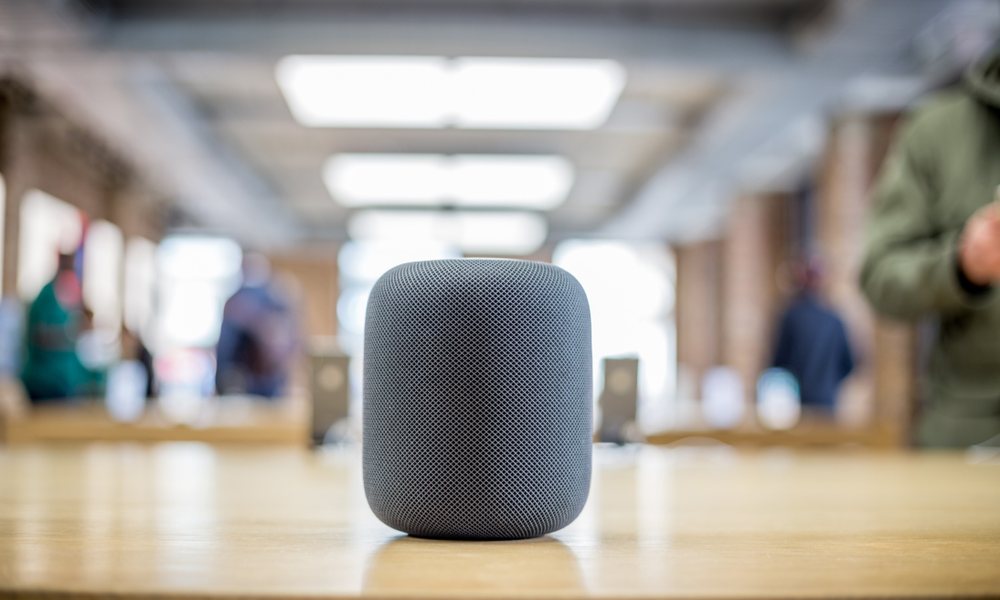HomePod Sales Grew 45 Percent Over Holiday Quarter, But Actually Lost Market Share
 Credit: Ksenija Toyechkina / Shutterstock
Credit: Ksenija Toyechkina / ShutterstockToggle Dark Mode
While it’s probably not much of a surprise that Apple’s HomePod isn’t going to be a market leader anytime soon, Apple’s sales of the speaker do seem to be growing, despite disappointing sales in the first few weeks of the speaker’s launch.
A new market analysis report by Strategy Analytics reveals that Apple actually saw a growth in HomePod sales of over 45 percent during the holiday quarter, with Apple shipping 1.6 million units in Q4 2018. However, this ultimately ended up being a drop in the bucket compared to sales by Amazon and Google, who each shipped 13.7 million and 11.7 million units, respectively.
In terms of market share, Amazon and Google continue to dominate, with the two companies making up over 65 percent of the total smart speaker market. In fact, Apple’s market share for the HomePad actually decreased last quarter to 4.1 percent despite the increase in sales; even though Apple saw a 45 percent increase, that was eclipsed by 91 percent growth in Amazon’s sales and 123 percent growth in sales of Google Home speakers.
Of course, Apple’s HomePod is a single, premium, $349 (or $329) speaker that is competing in a market where its two biggest competitors are producing a lineup of models that almost entirely sell for lower prices.
Amazon’s Echo Dot and Google’s Home Mini could be found for as little as $25 over the holiday season, and even Amazon’s most expensive Echo speaker can be had for less than half the price of Apple’s HomePod.
Only Google’s Home Max surpasses the price of the HomePod, and it’s a safe bet that it’s not Google’s best-selling model.
Apple has positioned the HomePod as a speaker first and a voice assistant second, but it’s also clearly a device only for those who are already deeply invested in the company’s ecosystem. HomePod can only stream audio from an iOS device via Apple’s own AirPlay protocol, and the Siri assistant is limited to playing music from Apple Music, and only controlling accessories that are compatible with Apple’s HomeKit platform. It’s a great speaker for Apple fans, but for everybody else, not so much.
Save $20 on an Apple HomePod at the iDrop Store.
Even for that audience, however, Siri has been criticized for lagging behind Amazon’s Alexa and Google’s Assistant, lacking features of the other platforms, such as the ability to personalize responses based on who in the family is talking to it, and adding new app integrations and skills.
Recent reports have indicated that Apple is making some serious efforts to improve Siri, refocusing the team on longer-term goals and recently acquiring a startup that specializes in adding new skills to smart speakers. However, even if Siri could run miles ahead of Amazon Alexa and Google Assistant, the asking price of the HomePod is going to keep it as a niche device in a market where entry-level voice assistants can be had for a tenth of the price.
Respected analyst Ming-Chi Kuo suggested last year that Apple may be considering a lower-cost version of the HomePod in order to better position it as a voice assistant and less as a premium speaker, although Kuo also added that this wouldn’t likely help Apple’s sales in the long-term without making signifiant improvements to Siri and adding more languages and features. Since that time, HomePod has launched outside of the U.S., coming to Australia, Canada, China, France, Germany, Hong Kong, Mexico, Spain, and the U.K.. By comparison, however, Google’s Home smart speaker is available in 13 countries, and Amazon’s Alexa is available in 41 countries.
While there’s been no evidence that Apple is actually working on another model of the HomePod, it’s entirely possible that Apple is endeavouring to make these kinds of improvements before releasing a lower-cost version, since such a model would undoubtedly need to be more focused on the voice assistant rather than sound quality, the latter of which has been the main selling point used by Apple to promote HomePod from the very beginning.
It’s important to note that Strategy Analytics’ data is based on market research estimates, as Apple doesn’t disclose unit sales or revenue for the HomePod specifically, but instead reports it under the broader category of “Wearables, Home, and Accessories” which includes other significant products such as the Apple Watch, Apple TV, AirPods, and even Beats headphones.






